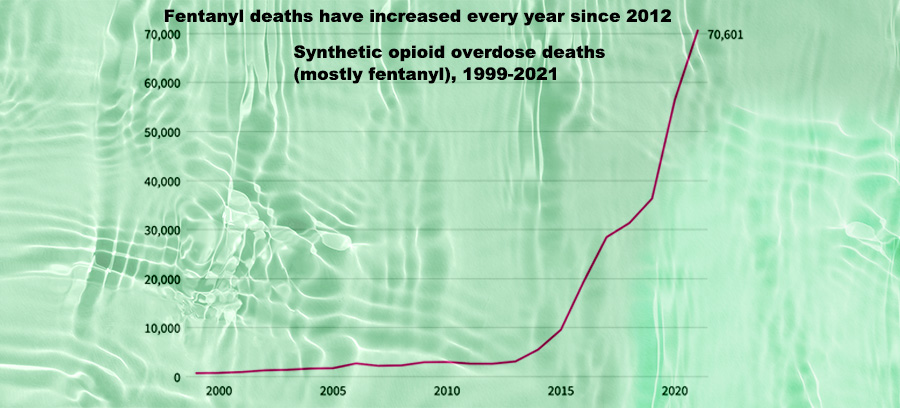What is Fentanyl?
Fentanyl is a synthetic opioid that was first developed in 1959 and introduced in the 1960s as an intravenous anesthetic. Fentanyl was also used for pain management as a transdermal patch in cancer patients. It is 50-100 times stronger than morphine.
As an illicit drug, fentanyl is added to heroin to increase potency. Although heroin is the primary drug to which fentanyl is added, there is increasing incidence of other drugs such as cocaine and methamphetamine are also being laced with fentanyl. Fentanyl-laced drugs are extremely dangerous, and many users may be unaware that their drugs are laced with fentanyl. The high potency of fentanyl has resulted in an overdose epidemic in the US. Even a small amount of this drug can be fatal.
Amid the COVID-19 pandemic, increase in the illegal drug supply had fueled an enormous surge of overdose mortality rates among Americans. Prescription medications, including opioids like oxycodone and hydrocodone, drove the so-called first phase of the opioid crisis in prior years. Fentanyl is becoming the leading offender.
Starting in 2014 (4,223 deaths in 2014), fentanyl-related fatalities began to increase every year. There were 8,251 fatalities in 2015. These fatalities increased to 18,335 in 2016. According to the Centers for Disease Control and Prevention, there has been a considerable increase in opioid-related mortality.
Why is Fentanyl Such a Hazardous Drug?
Fentanyl is common in many street-purchased and counterfeit prescriptions of opioid and benzodiazepine tablets. It’s easy to consume a dosage that’s too high since it’s so potent.
Synthetic Opioid Overdose Data
A drug overdose is more likely to kill an American than a traffic accident. Over 70,000 Americans died from drug overdoses in 2017, with opioids being the top cause of death. Opioids include illegal fentanyl and heroin, but also widely prescribed pain relievers like oxycodone.
In 2019, more than 36,000 people died in the United States from synthesized opioids (apart from methadone), which is greater than any other form of opioid. Synthetic opioid-related mortality climbed by more than 15% between 2018 and 2019, accounting for over 73% of all opioid-related deaths. Synthetic opioid overdose fatalities were over 11 times greater in 2019 than in 2013.
According to previous studies, trends in synthetic opioid-related mortality have previously been linked to the number of drug shipments collected by law authorities that test positive for fentanyl, but not to fentanyl prescription rates. According to these statistics, the rise in synthetic opioid-related mortality is due to the increasing fentanyl-related fatal overdoses.
Who Has Been the Most Severely Impacted?
This analysis shows the death rates among common races, ethnicities and areas:
While whites had the most outstanding overall incidence of fentanyl deaths, researchers discovered that mortality rates among African Americans and Hispanics grew faster. For example, from 2011 and 2016, African Americans experienced a 140.6 percent yearly rise in fentanyl mortality rates, while Hispanics experienced a 118.3 percent yearly growth. Whites, on the other hand, had an annual increase of 61 percent.
Furthermore, the researchers discovered that fentanyl was more prevalent in some places than others. The East Coast, comprising New England, the mid-Atlantic, and the Great Lakes area, had significant increase in overdose fatality rates.
The Ohio Department of Health investigated the use of fentanyl, citing concerns that it is spreading swiftly across the state. Not only that, it is also driving up the number of overdose deaths considerably. According to state statistics, the number of people killed by fentanyl overdoses in Ohio climbed from 84 in 2013 to 502 in 2014.
According to the report’s primary data, white men with a background of drug abuse or who were coping with a mental illness condition were at the highest risk of fentanyl overdoses. Overdosing is most likely to happen after the individual had recently been discharged from a prison, hospital, or drug addiction treatment center. Individuals who had previously been given a high-dose opioid medication due to various reasons such as pain management for injuries are also vulnerable to overdose.
With the opioid epidemic devastating the country, fentanyl has risen to the top of the list of fatal overdoses. As a result, the researchers hope that by better comprehending national tendencies and anomalies in fentanyl-related drug deaths, health care policies and programs can be better informed in the future.
What Can Be Done to Prevent Fentanyl-Related Deaths?
To avoid opioid overdose deaths, emergency medical workers and first responders commonly utilize Naloxone, an opioid antagonist medicine that rapidly reverses an opioid overdose. However, one of the most effective tools in management is regular monitoring and testing of addicted and at-risk populations.
Jant Pharmacal offers the first FDA cleared, CLIA Moderate Complexity fentanyl assay. More information about the Fentanyl Urine Screening Kit is available here.


